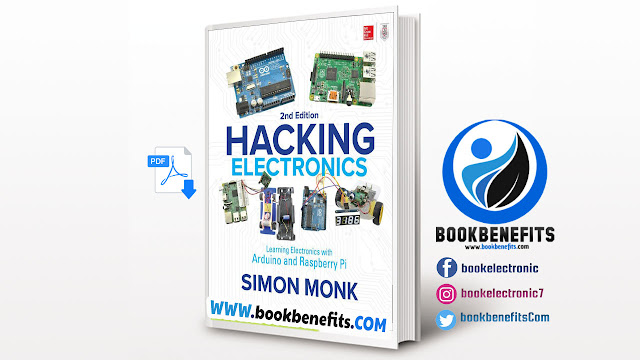Download Hacking Electronics: Learning Electronics with Arduino and Raspberry Pi PDF
Hacking Electronics: Learning Electronics with Arduino and Raspberry Pi PDF
Picture Of The Book
Hacking Electronics: Learning Electronics with Arduino and Raspberry Pi PDF
About Of The Book
This is a book about “hacking” electronics. It is not a formal, theory-based book about electronics.
Its sole aim is to equip the reader with the skills he or she needs to use electronics to make
something, whether it’s starting from scratch, connecting together modules, or adapting existing
electronic devices for some new use.
You will learn how to experiment and get your ideas into some kind of order, so that what
you make will work. Along the way, you’ll gain an appreciation for why things work and the
limits of what they can do, and learn how to make prototypes on solderless breadboard, how
to solder components directly to each other, and how to use protoboard to make more complex
soldered circuits.
You will also learn how to use the popular Arduino microcontroller board, which has become
one of the most important tools available to the electronics hacker. There are over 20 examples of
how to use an Arduino with electronics in this book.
You will also learn how to use the Raspberry Pi (a tiny Linux computer) as a tool for
electronics hacking.
Electronics has changed. This is a modern book that avoids theory you will likely never use
and instead concentrates on how you can build things using readymade modules when they are
available. There is, after all, no point in reinventing the wheel.
Some of the things explained and described in the book include.
●Using LEDs, including high-power Lumileds and Addressable LED strips (Neopixels)
●Using LiPo battery packs and buck-boost power supply modules
●Using sensors to measure light, temperature, acceleration, sound level, and color
●Interfacing the Raspberry Pi and Arduino with external electronics
●Using servo motors
●A smartcard RFID tag reader
●An Internet-controlled hacked electric toy
●A device for measuring color
●An ultrasonic rangefinder
●A remote control robotic rover
●An accelerometer-based version of the “egg and spoon” race
●An audio amplifier
●A bug made from a hacked MP3 FM transmitter
●Working brakes and head lights that can be added to a slot car
●A smart-card reader/spoofe
Contents Of The Book
Chapter 1 Getting Started
The book starts off by telling you where you can buy equipment and
components, as well as things to hack. This chapter also deals with the
basics of soldering and focuses on a project to hack an old computer fan
to make a fume extractor for use while soldering.
Chapter 2 Components
This chapter introduces electronic components—or at least the ones you
are likely to use—and explains how to identify them and describes what
they do. It also introduces a small amount of essential theory, which you
will use over and over again.
Chapter 3 Basic Hacks
This chapter contains a set of fairly basic “hacking” how-tos, introducing
concepts like using transistors with example projects. It includes hacking
a “push light” to make it automatically turn on when it gets dark and how
to control a motor using power MOSFETs.
Chapter 4 LEDs
In addition to discussing regular LEDs and how to use them and make
them flash and so on, this chapter also looks at using constant current
drivers for LEDs and how to power large numbers of LEDs and laser
diode modules.
Chapter 5 Batteries and Power
This chapter discusses the various types of battery, both single use and
rechargeable. It also covers how to charge batteries including LiPos.
Automatic battery backup, voltage regulation, and solar charging are
also explained.
Chapter 6 Hacking Arduino
The Arduino has become the microcontroller board of choice for
electronics hackers. Its open-source hardware design makes using a
complex device like a microcontroller very straightforward. The chapter
gets you started with the Arduino and includes a few simple how-tos,
like controlling a relay, playing sounds, and controlling servo motors
from an Arduino. It also covers the use of Arduino expansion shields.
Chapter 7 Hacking with
Raspberry Pi
The Raspberry Pi single board computer is great for hacking together
electronic projects that require a bit more power than an Arduino can
provide, or that need a network connection or large display. In this
chapter you will learn how to set up and use a Raspberry Pi, as well as
connect electronics to its GPIO pins.
Chapter 8 Hacking with
Modules
When you want to make something, you can often use readymade
modules at least for part of the project. Modules exist for all sorts of
things, from wireless remotes to motor drivers.
Chapter 9 Hacking with
Sensors
Sensor ICs and modules are available for sensing everything from
temperature to acceleration. In this chapter, we explore a good range
of them and explain how to use them and connect some of them to an
Arduino.
Chapter 10 Audio Hacks
This chapter has a number of useful how-tos relating to electronics and
sound. It includes making and adapting audio leads, as well as audio
amplifiers, and discusses the use of microphones.
Chapter 11 Mending and Breaking Electronics
Mending electronics and scavenging useful parts from dead electronics
are a worthy activity for the electronics hacker. This chapter explains
how to take things apart and sometimes put them back together again.
Chapter 12 Tools
The final chapter of the book is intended as a reference to explain more
about how to get the most out of tools such as multimeters and lab
power supplies.
Information Of The Book
File Name Of The Book : Hacking Electronics: Learning Electronics with Arduino and Raspberry Pi PDF
File Size : 14 MB
language : English
Page : 305
Format : PDF
Author : Dr. Simon Monk

